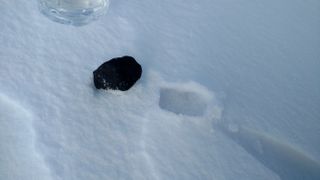Fireball Finds! Meteorite Fragments from Dazzling Michigan Meteor Found on Ice
Meteorite hunters in Michigan found six rocks Thursday (Jan. 18) that they say came from a spectacular fireball that lit up local skies earlier this week.
The team of Larry Atkins, Robert Ward and Darryl Landry made the finds on an isolated Michigan lake — they declined disclosing the exact location so as not to draw unwanted attention to the lake and its residents. In an interview with Space.com, Atkins said he plans on continuing the hunt for at least the next week.
The first find happened around 9 a.m. EST (1300 GMT), and Atkins discovered a second one himself just 15 minutes later. "It looked like a perfect black charcoal briquette, with a little snowdrift on top," Atkins told Space.com Thursday. Based on his two decades of experience hunting meteorites — fragments of rocks that remain after some space-rock fireballs break up in the atmosphere — he said there was no question it was from space. The rock showed up clearly on the fresh ice, although from a distance Atkins did question whether it was a small pile of leaves. [Small Michigan Meteor Packed a Seismic Punch, Experts Say]

The finds had masses of between 20 and 100 grams, and were small enough to "fit in the palm of your hand," Atkins said. He added that from a quick look at the meteorites, they all appear related and they all looked like ordinary chondrites — the most common type of meteorite found on Earth. The team has already picked out one sample they plan to send to the Field Museum in Chicago, Atkins said. The rest they will keep for their personal collections, they said.
Atkins has been searching for space rocks for two decades. This find comes only two years after another team he participated in found several space rocks from a Florida fireball. For this Michigan fireball, Atkins, who spends his winters in Arizona, made a special trip back to his hometown area of Ann Arbor to participate in the search.

Fellow team member Robert Ward also flew in from Arizona, arriving at 1:30 a.m. EST (0530 GMT) Jan. 18. By 3 a.m., he was already scouting for possible locations, based on radar information his team received from the American Meteor Society and NASA. His first find came around 10 a.m. — another chondrite, he said. Ward gave a phone interview to Space.com yesterday (Jan. 19) while out on the ice, scouting for more meteorites.
"The data was spectacular — it was a very quick discovery and everything came together," said Ward, referring to the amount of information available to help him make the discovery. He has searched for meteorites since age 13, roughly 28 years ago, and has made 600 distinct finds on all continents except Antarctica. "I'll be here until Sunday, but I may come back out … later in a few weeks."
Get the Space.com Newsletter
Breaking space news, the latest updates on rocket launches, skywatching events and more!

Public and professional participation
The excitement of the fireball sent people out into the Michigan cold in hopes of finding a piece of space. Among them was University of Michigan seismologist Larry Ruff, who thought it would be a fun idea to venture out in the fresh snow and go meteorite hunting. He didn't find anything, but enjoyed the experience, he said.
"It's been really cold here, but today was one of the warmer days," Ruff told Space.com in an interview Jan. 18, explaining that temperatures then were as high as 20 degrees Fahrenheit (minus 7 degrees Celsius). "That explains why everyone was happy to get out of the house and look for some meteorites."
Ruff searched in a park along with fellow Earth sciences professor James Gleason, who specializes in the composition of meteorites. The professors met lots of other wannabe meteorite-finders, too. Ruff joked that he was jealous that others had made the first finds, but added, "the debris field area is so huge, and somebody has to make a find."
Ruff, who oversees the Ann Arbor seismic station at the University of Michigan, said the fireball produced one of the strongest seismic waves he had ever seen. He added that "seismic wave" did not mean an earthquake, but signified a disturbance in the atmosphere.
Sightings across the Midwest
The American Meteor Society has received 657 reports about the fireball since it lit up the skies Tuesday night (Jan. 16), according to their website, with observers reporting from a number of states, including Michigan, Wisconsin, Iowa, Illinois, Indiana, Ohio, West Virginia and Pennsylvania. Some observers even saw it from the province of Ontario, in Canada.
"This was a very slow moving meteor — speed of about 28,000 miles per hour (45,000 km/h)," the AMS added in a news release issued Wednesday (Jan. 17). "This fact, combined with the brightness of the meteor (which suggests a fairly big space rock), shows that the object penetrated deep into the atmosphere before it broke apart (which produced the sounds heard by at least 77 observers)."
The composition and size of the meteor isn't well-understood yet, but early reports suggest that it was only a few feet in size, rather than the impressive Chelyabinsk bolide diameter of 17 meters (51 feet). When that bolide exploded over Russia in 2013, it injured hundreds of people and caused property damage, mainly because the sonic wave from the meteor shattered glass.
Meteorites range from the durable to the delicate. If the Michigan bolide was made of lesser stuff than iron or stone, exposure to the elements will erode any fragments quickly. That's why Ruff said it's important to get outside quickly, to make sure as much evidence is gathered as possible.

Record of the early solar system
Over 50,000 meteorites have been found on Earth alone, according to NASA. Of those, about 99.8 percent come from asteroids — small, rocky bodies in our solar system. This means that meteorites serve as a record of the early solar system, since asteroids are leftover fragments from the small bits of rock and gas that formed the planets roughly 4.5 billion to 4.6 billion years ago.
"The study of meteorites tells us much about the earliest conditions and processes during the formation and earliest history of the solar system, such as the age and composition of solids, the nature of the organic matter, the temperatures achieved at the surface and interiors of asteroids, and the degree to which materials were shocked by impacts," NASA officials said.
This fireball over Michigan was too small to cause damage, but past events on Earth have. A meteorite strike on Earth about 66 million years ago is one of the principally cited causes for the dinosaurs' extinction. The impact left behind a 180-mile (300 kilometer) crater called Chicxulub, which is in the Yucatan Peninsula. Another well-known impact site is Meteor Crater in Arizona, which is about 0.6 miles (1 km) across. Craters are also found all over the solar system — on the moon, Mars and many other locations.
NASA has a Planetary Defense Coordination Office charged with looking for potentially hazardous objects careening toward Earth. They haven't yet seen an object that poses an imminent threat to life on Earth, but NASA and its partners continue searching, just in case. Scientists are also working on several technologies to deflect or destroy threatening asteroids, such as lasers or missiles.
Follow us @Spacedotcom, Facebook and Google+. Original article on Space.com.
Join our Space Forums to keep talking space on the latest missions, night sky and more! And if you have a news tip, correction or comment, let us know at: community@space.com.

Elizabeth Howell (she/her), Ph.D., is a staff writer in the spaceflight channel since 2022 covering diversity, education and gaming as well. She was contributing writer for Space.com for 10 years before joining full-time. Elizabeth's reporting includes multiple exclusives with the White House and Office of the Vice-President of the United States, an exclusive conversation with aspiring space tourist (and NSYNC bassist) Lance Bass, speaking several times with the International Space Station, witnessing five human spaceflight launches on two continents, flying parabolic, working inside a spacesuit, and participating in a simulated Mars mission. Her latest book, "Why Am I Taller?", is co-written with astronaut Dave Williams. Elizabeth holds a Ph.D. and M.Sc. in Space Studies from the University of North Dakota, a Bachelor of Journalism from Canada's Carleton University and a Bachelor of History from Canada's Athabasca University. Elizabeth is also a post-secondary instructor in communications and science at several institutions since 2015; her experience includes developing and teaching an astronomy course at Canada's Algonquin College (with Indigenous content as well) to more than 1,000 students since 2020. Elizabeth first got interested in space after watching the movie Apollo 13 in 1996, and still wants to be an astronaut someday. Mastodon: https://qoto.org/@howellspace
